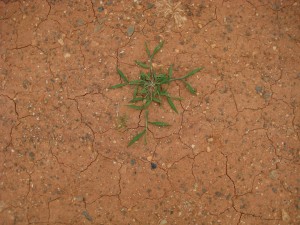Crabgrass.
It does look a bit like a crab, sidling sideways across the dry ground. But I think it’s the closest thing in the plant world to a spider: many-legged, sprawling, sneaky, ubiquitous. Hated.
It’s a weed, a backyard pest, true. But you have to give a little grudging admiration to a plant that’s so good at survival in such a range of habitats. Flower gardens, lawns, cornfields, the barren soil of scraped and bulldozed construction sites: crabgrass loves’em all. Like spiders, crabgrass can flourish almost anywhere, from early in the spring to long after the frost. And when it’s time to reproduce, both create lavish amounts of offspring–a single crabgrass plant can generate more than 150,000 seeds.
It’s not a species, it’s a genus–Digitaria–and just as there are lots of species of spiders, there are lots of types of crabgrass: short, long, hairy, smooth, purple. There’s Texas crabgrass, Madagascar crabgrass, in fact it’s found all over the world: the struggle to keep crabgrass out of the flowerbed is one of the things that unites humanity.
One of botany’s many ironies is how quickly human emotions towards a plant change–not gradually but in a 180 degree reversal. Crabgrass has been cultivated as a food crop since the Stone Age–the seeds make a nourishing, if not exactly gourmet, sort of porridge. European settlers brought seeds to North America, calling cooked crabgrass “manna grits.” And it was officially imported by the US government in 1849 as a forage crop. Since it can flourish in hot, dry landscapes and is packed with nutrition, it seemed like a great idea at the time. It’s certainly easy to grow. Sow it once and you never have to again.
If you google “crabgrass” you’ll find nothing but dozens of sites telling you how to get rid of it, with lots of lethal information on which herbicide will poison it most effectively. But, as with spiders, I prefer peaceful coexistence, with a little rueful admiration for their durability. 





Recent Comments